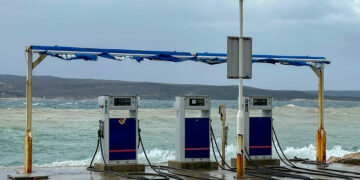The off-season at the Adriatic Sea in Italy, Slovenia and Croatia lures this year with much sun, particularly empty beaches in addition, different regulations and measures for German and Austrian holiday-makers because of the Coronavirus with the entry and departure as well as in the transit. We dared the attempt to summarize the most different regulations and measures once for holiday-makers, who want to enjoy the off-season still at the Adria despite COVID-19.
Which measures and travel regulations apply to vacationers from Austria?
Austria had been able to agree on uniform measures and travel regulations with Slovenia early on, but Croatia, one of the Austrians’ favorite travel destinations, fell by the wayside. While for example Austria warns generally of journeys to Croatia, Germany expressed only a partial travel warning as measure.
Measures for countries with stable COVID 19 situation
The Federal Ministry for European and international affairs (Austria) describes on its Internet side the measures for journeys: “The entry to Austria from countries, in which a stable COVID 19 situation prevails, is possible without restrictions. The corresponding countries are at present (conditions: 24.08.2020): Andorra, Belgium, Denmark, Germany, Estonia, Finland, France, Greece, Ireland, Iceland, Italy, Latvia, Liechtenstein, Lithuania, Luxembourg, Malta, Monaco, Netherlands, Norway, Poland, San Marino, Switzerland, Slovakia, Slovenia, Spain (only Canary Islands), Czech Republic, Hungary, Vatican, United Kingdom and Cyprus”.
measures for countries where there is no stable COVID-19 situation
Entering Austria from countries where there is no stable COVID-19 situation is now possible with a health certificate. “The countries in question are currently (as of 24 August 2020): Albania, Bangladesh, Belarus, Bosnia and Herzegovina, Brazil, Bulgaria, Chile, Croatia, Egypt, Ecuador, India, Indonesia, Iran, Kosovo, Mexico, Moldova, Montenegro, Nigeria, Northern Macedonia, Pakistan, Peru, Philippines, Portugal, Romania, Russian Federation, Senegal, Serbia, Spain (except the Canary Islands), Sweden, South Africa, Turkey, Ukraine, United States (USA) and the province of Hubei in China.
What measures are threatened in Austria when entering from countries with unstable COVID-19 situation ?
If a person has stayed in a country with an unstable COVID-19 situation within the past 10 days, entry is possible either with a medical certificate of health confirming a negative PCR test and the test was not more than 72 hours ago, or a 10-day (home) quarantine must be initiated after entry. For this purpose, a confirmation of accommodation must be presented and any costs incurred must be paid by the patient. The quarantine can be terminated if a PCR test is negative.
Which measures do Austrians still have to take into account?
In order to avoid longer waiting times at the Slovenian-Austrian border crossings, the Austrian government has taken measures to recommend that the form provided for this purpose be filled out completely and correctly before entry. Here you can find the forms in German and English. However, this form is not always required for random checks. Depending on the traffic jam situation, the measures at the border to Austria may change upon entry.
COVID-19 tests in Croatia should be used with caution
In addition, travel returnees who still want to be tested in Croatia should note that the laboratories there do not always deliver the results on time according to information from returning holidaymakers. If the tests are organized however over larger hotel chains or charter enterprises, there were so far after empiric reports, which reached the SeaHelp editorship, so far no problems.
Measures against border traffic jams: Select alternative route
Anyone wishing to find out about the current congestion situation at individual border crossings will find constantly updated information on promet.si, a Slovenian website. As an effective measure against traffic jams when entering Austria, Austrians are advised to use smaller border crossings if necessary.
What applies to German vacationers?
measures at entry or exit Austria/Italy
German holiday-makers who still want to spend their vacations in Italy, Slovenia or Croatia should know With an arrival and return journey over Italy, a way, which probably most Istrien vacationers select, the border crossings are opened for the entry from Austria to Italy.
Special measures Italy
According to the publication of the German Foreign Office, for those who come from Croatia and wish to stay longer in Italy, the following applies: “For travelers from Greece, Malta, Spain and Croatia, the presentation of a negative COVID 19 test, which must not be older than 72 hours, or the performance of a test upon entry is required. And further it means: “The passage by Italy is possible from the … EU/Schengen states and the United Kingdom of Great Britain and Northern Ireland without restrictions.
For yacht owners, who return from the Törn from Croatia to Italy, in order to then travel further to Austria or Germany the measures mean concretely: Who continues to travel after putting on within 12 hours, has to fear nothing, for him the procedure is still evaluated as transit, how the Italian embassy in Berlin on request communicated.
Open border crossings
The main border crossings on the freeways leading from Austria to Slovenia are also open for both entering and leaving Slovenia. Smaller border crossings to Slovenia, such as the border at Wurzenpass, are only open to Austrian citizens on the basis of a bilateral agreement. In the case of a control measure, Germans are referred to the border crossings authorized for them when entering Slovenia from Austria or vice versa.
Previously completed documents
With the entry from Slovenia to Croatia holiday-makers, both from Austria and from Italy, should register themselves generally under “enter croatia”. German holiday-makers should download themselves before vacation beginning already additionally the form in and passage Austria from the Internet and fill out. Whether it is needed then at the border, is dahingestellt and lies in the discretion of each border official, who takes over the execution of the arranged measures.
Quarantine measures for German tourists
Anyone entering Germany from abroad can be tested for the corona virus free of charge within 72 hours. Entering Germany from risk areas are obligated to the test since August 8, the Federal Ministry of Health announces. Among the current risk areas in Croatia Split, Sibenik and Zadar rank according to list of the Robert cook institute.
No quarantine in transit
Further it says here: “Anyone who enters the Federal Republic of Germany and has stayed in a risk area within 14 days prior to entry is obliged to go directly home or to another suitable accommodation after entry and to isolate himself there for 14 days. This does not apply if someone has only passed through a risk area and has not stayed there. The responsible health authority monitors the quarantine obligation. The regulation of the quarantine obligation is issued by the federal states in their own responsibility. Therefore, please ask on the website of the federal state in which you live or will be staying what the quarantine regulations there actually look like.
Conclusion for Germans and Austrians
Who would like to enjoy the off-season at the Adriatic Sea, should inform himself before travel beginning about the appropriate measures and travel regulations. In this contribution the most important links are summarized, but also their expiration date cannot be estimated finally by the SeaHelp editorship. Much also depends on the epidemiological developments in the respective countries. A look at our homepage before you start your journey can’t hurt in any case. In general, however, the following measures apply: Austrians must after the Croatia journey in quarantine, which can be broken off only by a negative COVID 19 test, Germans only if they were (conditions 6 September 2020) in the regions Zadar, Sibenik or Split. Transit through Slovenia and Austria is possible for German tourists, but with certain restrictions.
SeaHelp survey:
Anyone who is currently planning a vacation in Croatia and is behaving sensibly on the spot in terms of corona protection measures does not have to worry less about an infection with the corona virus, as when staying in Germany or Austria, as the interim results of the survey showed. Nevertheless, we would welcome other water sports enthusiasts to participate in the SeaHelp survey in order to obtain as comprehensive an overall picture as possible.














